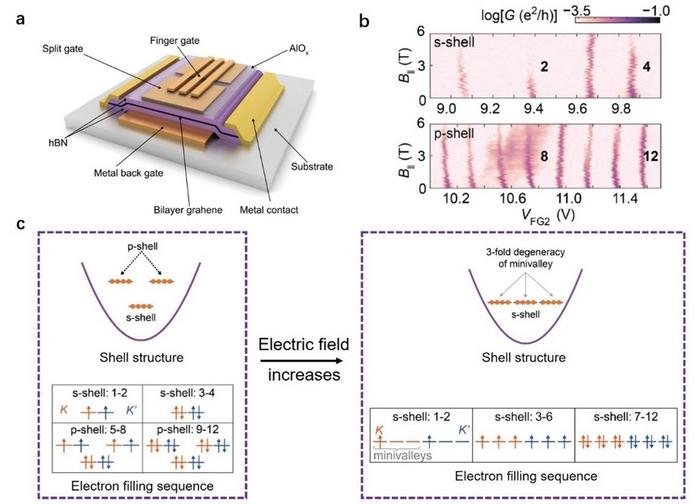A groundbreaking study from the University of Science and Technology of China has unveiled remarkable advancements in the field of bilayer graphene quantum dots (BLG QDs), focusing specifically on the electrically induced manipulation of spin filling sequences. The research, spearheaded by Professor Guo Guangcan and his team, reveals how the intricate effects of trigonal warping in bilayer graphene can be harnessed to control electron states, a finding with significant implications for the future of quantum computing and advanced electronic devices.
Bilayer graphene, with its unique structural and electronic properties, has rapidly gained attention in the scientific community. When subjected to an out-of-plane electric field, bilayer graphene exhibits the ability to develop a tunable band gap. This characteristic is essential for a variety of applications including transistors and sensors. The research team meticulously investigated how the trigonal warping effect, which emerges from the specific arrangement of graphene layers and their coupling, critically impacts the behavior of charge carriers within the quantum dot.
The experiment utilized a finely-tuned quantum dot device that allowed precise control over the electron filling sequence within the bilayer graphene structure. Initially, the researchers applied a moderate perpendicular electric field, leading to the occupation of the s-shell with a total of four electrons—two with spin-up and two with spin-down. This seemingly simple finding laid the groundwork for further exploration into the more complex dynamics of spin and valley degeneracies in bilayer graphene.
As the team applied a stronger electric field, they noticed a dramatic shift in the electron filling capacity of the s-shell, which now accommodated up to 12 electrons, all exhibiting the same spin polarization. This transition from a fourfold to a twelvefold degeneracy highlighted the profound impact of the trigonal warping effect, compelling the researchers to delve deeper into the interplay between electron spins and valleys within the quantum dot.
To complement their findings, the research group executed an array of magnetotransport measurements, exploring how external magnetic fields influenced the spin and valley filling sequences. These measurements were pivotal in showcasing the ability to modify the spin filling sequence electrically; shifting from an initial arrangement of “2 + 2 + 4 + 4” to a more uniform “6 + 6”. This critical observation suggested that the minivalley degree of freedom can indeed be leveraged to manipulate the spin, opening new avenues for quantum control.
The implications of this quantum manipulation are far-reaching. By demonstrating a method to electrically control the spin filling sequence, the researchers illuminated the potential for generating three-spin states and furthering the understanding of SU(3) symmetry in quantum systems. Such advancements could lead to entirely new forms of electronic phases, fundamentally shifting how electronic materials are designed and utilized in next-generation devices.
Furthermore, the study’s findings could have significant ramifications in the field of quantum computing, where the ability to control spins with precision is essential for developing qubits, the building blocks of quantum information technology. This research not only pushes the boundaries of existing knowledge but also poses intriguing questions about the potential of bilayer graphene as a platform for topological states and exotic quantum phenomena.
In practical terms, the research opens the door for innovative applications in spintronics, a field dedicated to the manipulation of electron spins for better data storage and transfer technologies. The potential to control spin states at such a granular level suggests a future where information can be processed faster and with greater efficiency, marking a significant leap forward in material science and engineering.
In summary, the exploration of spin filling sequences in bilayer graphene quantum dots represents a landmark achievement in the ongoing quest for advanced materials capable of meeting the demands of future electronic and quantum technologies. By providing a clearer understanding of the complex interplay between electrons within bilayer graphene, this research paves the way for subsequent studies and innovations in both theoretical and applied physics.
As scientists continue to investigate the exciting properties of bilayer graphene and refine their techniques, the potential for new discoveries remains vast. The research team’s commitment to unraveling the complexities of quantum states showcases not only their expertise but also their vision for a future where quantum materials could revolutionize technology as we know it.
The intersection of quantum mechanics and material science is becoming an increasingly rich ground for innovation. As researchers delve deeper into the properties of materials like bilayer graphene, they move closer to unlocking the full potential of quantum mechanics, paving the way for technological advancements that could redefine the boundaries of what is possible.
Subject of Research: Electrically Manipulating Spin Filling Sequences in Bilayer Graphene Quantum Dots
Article Title: Switching Spin Filling Sequence in a Bilayer Graphene Quantum Dot through Trigonal Warping
News Publication Date: 21-Jan-2025
Web References: https://journals.aps.org/prl/abstract/10.1103/PhysRevLett.134.036301
References: http://dx.doi.org/10.1103/PhysRevLett.134.036301
Image Credits: Guo-Quan Qin et al.
Keywords
Bilayer Graphene, Quantum Dots, Spintronics, Quantum Computing, Trigonal Warping, Electronic Properties, Spin Filling Sequence, Magnetotransport, SU(3) Symmetry, Exotic Phases.
Tags: advanced electronic devices researchapplications of bilayer graphene in electronicsbilayer graphene quantum dotscharge carrier behavior in quantum dotselectrically induced spin manipulationelectron states control in quantum dotsgraphene layer coupling effectsprecise electron filling sequence controlquantum computing advancementstrigonal warping effects in graphenetunable band gap in bilayer grapheneUSTC graphene study





